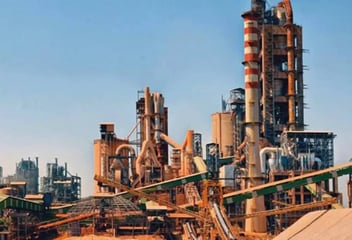How Polluting is The Cement Industry? Environmental & Regulatory Impact
The cement industry is among India’s most polluting industries. Image courtesy: businesstoday.in
The Indian cement industry is the second-largest producer of cement globally. In the financial year 2020, the giant industry had a turnover of Rs 64,000 crore. Dominated by around 30 prominent players, the cement industry in India comprises around 210 large cement producing plants and 365 small ones.
On the other hand, the cement industry is one of the most significant contributors to air pollution1. The cement industry contributes to around 7% of global carbon emissions. Particulate matter (PM) emissions from cement plants are very high, and cement is understood to be the most polluting industry in the world.
Effects of Pollution From Cement Industry on Human Life
Did you know that a single cluster of large-scale cement plants in a North Indian state is responsible for 5% of the world’s anthropogenic CO2 emissions7?
The effects of the cement industry pollution on life can be very severe. Below are some of the findings on its impact on humans and human-made systems:
- Random tests conducted on workers in Indian cement industries in Bengal and Tamilnadu have shown that 1/5th of the worker population is affected by diseases such as bronchitis, asthma and obstructive respiratory disease among others2.
- A recent study in Sri Lanka, which has ecological and geographical proximity with India, found that over 14% of the people living close to cement factories are afflicted with respiratory disorders2.
- In an interesting study conducted in the US, the economic benefits of reduced PM emissions from the American cement industry were estimated to range between 0.76 and 3.97 million USD annually3. The implications of such a finding in India, which produces three times the amount of cement produced by the US, are evident.
.webp)
Sustainability Challenges Faced by the Cement Industry
For a lot of cement companies, emissions continue to be high, despite having installed pollution control systems.
We come across news articles from time to time, citing cement firms paying heavy fines to the tune of tens of lakhs, if not higher6; or sometimes, even shutting plants for violating pollution norms.
Shutting down a plant even for a month can seriously impact a company's sales and overall efficiency.
The cement industry pollution mainly consists of dust or particulate matter, NOx, SOx, carbon oxides and methane, among others. Cement being the major contributor to air pollution, an approximate number of 4,90,000 annual deaths may be attributed to emissions from the cement industry.
Further, pollution from cement industries pose a threat to the life of surrounding flora and fauna.
One of the major problems of the cement industry in India is unaccounted or ‘fugitive’ emissions.
Fugitive emissions refer to pollutants that are ‘fugitive’ or escape from a source without being accounted for. Regular emissions from known sources are accounted for and hence easier to track and control. Fugitive emissions, on the other hand, are difficult to track since their source is unknown. Hence, they contribute to ambient air pollution in an untraceable way. The problem of fugitive emissions occurs during every stage of the cement manufacturing process and poses a huge challenge.
Conventionally, cement industry pollution control equipment includes electrostatic precipitators, baghouses, pulse jet filters, and industrial scrubbers.
However, these have a limited and clearly defined area of coverage, and therefore, cannot treat fugitive emissions very effectively. The above-mentioned air pollution control techniques are energy-consuming, require regular maintenance, and are expensive, given their capacity of coverage. They are not very effective in treating ambient air pollution either.
Wondering how to treat fugitive emissions at your cement manufacturing plant?
Book a free consultation with our experts today!
(This article is conceptualzied and co-written by Shashank Aggarwal & Vidhya Sreenivasan)
Citations
- https://economictimes.indiatimes.com/news/international/world-news/cement-produces-more-pollution-than-all-the-trucks-in-the-world/articleshow/69919005.cms?from=mdr
- https://indianexpress.com/article/india/india-others/death-by-breath-why-building-dust-is-lethal-mix/
- https://www.witpress.com/elibrary/wit-transactions-on-ecology-and-the-environment/42/3892
- https://business.mapsofindia.com/cement/cement-industry-jobs.html
- https://link.springer.com/chapter/10.1007/978-3-030-44248-4_18
- https://www.thehindu.com/news/cities/Delhi/cpwd-fined-5-lakh-for-flouting-pollution-control-norms/article32704680.ece
- https://link.springer.com/article/10.1007/s10098-020-01998-6
- https://www.downtoearth.org.in/news/environment/cement-industry-misses-deadline-for-new-pollution-norms-57548

.svg)
.webp?width=1080&height=1080&name=Free%20Case%20Study%20Steel%20Plant%20(1).webp)






Post Comments